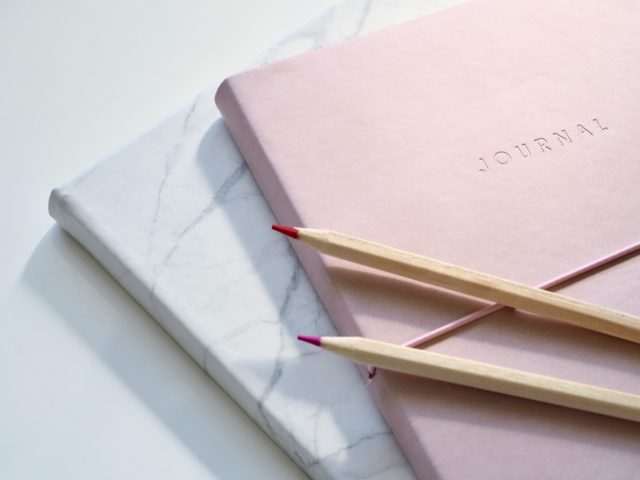
You’re sitting at your desk and you receive an important email. You’re in the middle of something, so you write yourself a quick sticky note so you don’t forget to respond. You finish your task, get a few other things done, and now you’re left with a nagging feeling that you have something to do…but you can’t remember what it is. It isn’t until the end of the day when you lift up your keyboard and find your sticky note that you remember to respond to the important email.
Does this sound familiar to you? Entrepreneurs, creatives, and busy people often find themselves in this situation, where the thoughts in their heads are scattered about the physical world in front of them. It’s an inefficient way to work and leads to frustration and wasted time. But there’s an alternative that can help you organize your thoughts across work, life, social, and more, all in one convenient place: a bullet journal.
What is a bullet journal and what is the bullet journal method?
The bullet journal method is a rapid logging system that can increase your productivity and help you organize your busy mind. Based on mindfulness practices, this system of notetaking and calendar organization is designed to quiet the constant stream of thoughts in your mind and help you bring your ideas into the real world.
A bullet journal notebook can really be any notebook. You don’t need to buy anything special to start bullet journaling, but a notebook with dot grid paper makes things a little easier. As you start bullet journaling, you’ll learn the methodology of symbols and systems that make it an effective, pleasing, mindful way to store your thoughts, ideas, goals, and to-do lists.
A bullet journal notebook can encompass every type of notebook, calendar, diary, and journal you own. It’s a streamlined system where your collections — essentially “chapters” of your journal — can vary from your work life to your personal thoughts and aspirations to your kids’ soccer schedules to a gratitude journal. With bullet journaling, there’s no need to separate your notes into different books and notebooks. In fact, that’s counter to the simplicity of bullet journaling.
The process is meant to lead you to a more mindful existence, where the thoughts that interrupt you throughout the day can be held, examined, and denoted without derailing your afternoon or being lost in the ether of forgotten ideas. Rather than a host of notebooks, sticky notes, and calendars that scatter your mind more than organize it, a bullet journal can help you feel more in control of your days, weeks, and months, all the while calming your busy mind.
The original bullet journal method was created and popularized by Ryder Carroll, a digital product designer who used bullet journal methodology to cope with his learning disability. His method has become one of the most popular organizational tools of the last decade, with a strong community of bullet journalers there to give each other tips and support. Carroll has kept the methodology open even for people who haven’t bought an official Bullet Journal, which he calls BuJo, but his book can help journalers push further into the mindfulness and intentional living promoted by bullet journaling.
How is it different from other journals?
Bullet journals are not like other journals because they aren’t meant to serve one purpose. They can be used as a calendar, diary, task list, grocery list, mood tracker, habit tracker, and more — in fact, they’re designed to be used for many purposes at once.
They also commonly feature dot grids rather than lines, which make it easier to customize your collections to your personal needs. (More on that later.) A bullet journal can be any size and you can still use the methodology without a dot grid notebook, but it helps get you in the headspace for bullet journaling.
Bullet journals are also different because they aren’t meant to be filled to the brim. Your bullet journal entries will often be short, simple, and perhaps more reductive than you’re used to. This is because the philosophy behind bullet journaling is all about putting your thoughts on the page so you can remember them later — not fleshing out your ideas for long periods of time.
That said, the great part about bullet journaling is you can (and should) customize the entire experience to your needs. If super short notes aren’t working for your diary collection, for example, you can design your pages to make space for longer pieces of writing.
Why do a bullet journal?

Bullet journals are a wonderful tool for anyone who feels like their days are filled to the brim with thoughts, tasks, appointments, and ideas — especially if you often find yourself forgetting or losing certain notes or thoughts. Because the bullet journal is meant to take only a few minutes each day, it’s ideal for busy folks who don’t feel they have the time to journal. It’s not just an organization tool you could have your assistant do for you.
It’s a mindfulness practice that’s meant to calm your mind and improve your memory through the process of writing by hand, so it can benefit leaders and entrepreneurs who don’t have a lot of time to themselves throughout the day.
Here are some of the distinct benefits of bullet journaling.
A highly customizable planner
Bullet journals are completely customizable. Because the pages are filled edge to edge with dots, you don’t have to follow the same old rules of writing in a notebook. You can create boxes where certain notes live, divide your page into sections to represent time or projects, or leave it as a stream-of-consciousness bullet list.
Not only are the pages themselves customizable, but you can also find a way to incorporate your planner. If you often find yourself writing outside of the lines in a measly square dedicated to the entire month of October, or if you just can never find a planner that has all the pages you need, the bullet journal is perfect. You can use the BuJo-approved collections titled Daily Log, Monthly Log, and Future Log to organize your planner, but the way you layout those pages are totally up to you.
There are millions of creative ideas for bullet journaling planners online, and spending the time to set up your favorite planner layout is a great way to spend some time in your own head. Planners are often too bulky, filled with tons of pages you’ll never use, and the wrong layout for your specific use. With a bullet journal, you can customize everything — you can even change your layout if you have an especially busy month or day.
Journal for creativity
Although many people think bullet journaling is just for CEOs and entrepreneurs to organize their busy schedules, it’s actually a creative outlet that can help you jumpstart your ideas and organize creative projects. You can create a collection set aside just for creative ideas, or you can include a diary collection that’s set up more like a traditional diary. You can also use the notebook for task lists associated with creative projects. As we’ve mentioned, it’s recommended that you keep your bullet journal entries short.
So, next time you have a killer creative idea, jot it down in a bullet journal entry in the simplest terms you can imagine. It just might make the project feel a bit more approachable next time you review your notes.
It’s also a creative activity in itself. Because you’re designing your own collections and finding unique ways to organize your pages, the process of journaling feels a bit like solving a puzzle or coloring in a coloring book. You’re thinking of creative solutions to organize your own thoughts, and the process itself can improve your focus and make you more creative throughout the rest of your day.
Budget-friendly planner
There’s nothing worse than going to the office supply store for a new planner every year and always having to pick out something different than last year. Even if you have a go-to planner that you use religiously, the cost of buying a new planner every calendar year is surely more than buying a new journal each time it fills up. (Did we mention that bullet journaling takes up about 60% of the space typical to-do lists take up?)
Planners are also expensive — especially when they’re customized. There’s no reason to pay extra for pages that have the dates printed on them. The calendar is free online, and with bullet journals, you can set your planner up exactly how you like it. No more writing in the margins or relabeling February as April because you ran out of space.
Not to mention, ending your calendar each year in December simply doesn’t make sense for most professionals. The year and all the projects, tasks, and thoughts you had during it don’t end on December 31 at midnight, so why should you get a brand new planner every January 1?
On top of all this, the bullet journal method encompasses more than the standard planner. It can be used for so many other things, like a gratitude log, daily task list, creative projects organizer, grocery list, and a lot more.
Improved productivity

The bullet journal works to improve your productivity, in more ways than one. First, the journaling itself should take you less than four minutes a day. Instead of spending 20 minutes each morning listing everything you need to do, then five more minutes later when you realize you forgot a few things, with a bullet journal you can jot your notes down in seconds and move on.
It also improves your productivity by providing you with a catalog of your thoughts, goals, ideas, completed tasks, and appointments. You’ll have all your past collections to look back on, including symbols that signify whether items were moved to the next month or week, or day, so you never lose track of a task.
With more mental clarity, you’ll work more efficiently and effectively. Rather than spending your day in a tizzy with a million thoughts running around in your head, you’ll take four minutes each morning to put those thoughts on paper. Then, when you get an idea or inspiration halfway through the day, adding a note to the appropriate collection takes just seconds.
Reduced stress and anxiety
The mental clarity you’ll see after starting bullet journals will lead you to a life with less stress and anxiety. Most people walk around in a state of stress and non-presence most of the time. But when you take the time to live in your thoughts, honor them by writing them down, and keep them in a safe place you can look back on anytime, you’ll experience less intrusive anxiety and stress.
The mindfulness aspect of bullet journaling is paramount, and you can’t avoid it. Once you start bullet journaling, you’ll notice that you feel more in control of your days and less scattered by thoughts entering and exiting your mind on a whim. This is, even more, the case if you also use it as a gratitude journal.
Helps you be more organized
Bullet journals promote organization, especially in people who find traditional to-do lists too simplistic or too daunting. You’ll denote your tasks, notes, and events with different symbols, so you never have to look at a long list of words and wonder which ones need to be taken care of. Your bullet journal will be easy to glance at and glean the information you need without taking several minutes to review the whole list in search of one item.
It also helps you stay more organized through the use of collections. These modules make it easier to keep your different types of journaling separate, without causing you to carry around several notebooks all the time. You can add to your collections as you see fit, and if you need more pages, don’t worry about leaving extra space — you can just put the new page numbers in your index so you know where everything lives.
If you struggle with keeping your notebooks organized, or you often can’t find the exact note you’re looking for, the bullet journal is perfect for you. The index makes it easy to find what you’re looking for, and it keeps you from getting stressed about the number of pages you have left in a given section. You can focus on what you need to do and write — the bullet journal will do the rest.
What tools do I need?
To start bullet journaling, all you need is a notebook (ideally with dot grid pages). Grab your favorite pen — just one color — and get ready to enter some journal entries. If you really want to get fancy, some people enjoy using a fountain pen for their journal entries due to the unique tactile feel it provides.
How do I start bullet journal?
Getting started with bullet journaling is easy, but it’s important to read over the basics first. You’ll want to set up a few collections right off the bat, but once you’re comfortable, you can start being creative with how you layout your journal. Here are the basics.
Index
The index is exactly what it sounds like — a map to your bullet journal. Leave one or two pages for your index, title it, and then fill it in after doing your other collections.
Each index item corresponds to one collection. You’ll number your pages after you’ve written on them, and update your index with page numbers as you go.
Key Signifiers

The key signifiers of the bullet journal method are a bullet point, a dash, and an open circle. The bullet point is for tasks; the dash is for notes; and the open circle is for events. An asterisk in the margin represents an important priority, whereas an exclamation point represents a wonderful idea that shouldn’t be forgotten.
As you continue writing in your bullet journal, you’ll also want to cross tasks out and move them to different months. Your bullet journal should be a record of what’s been completed, so don’t strike anything you want to keep as a task. Rather, change the bullet point to a greater-than arrow. This indicates that you’ve migrated the task to the next collection, page, or month.
Future Log
The future log serves as your big-picture planner. You can organize this into six months or several years — whatever makes the most sense for your workflow. Here, you’ll place items that you know will occur in a given time, but you’re not on that month yet. When you go to create that month, you’ll review your future log and migrate items to the monthly collection.
Month Log
The month log is typically a two-page snapshot of the current month. The left page is usually a calendar with specific tasks or events denoted, whereas the right page includes a monthly task list, events, and notes for that month. As the days go by, you can migrate items from your monthly log into your daily logs and cross them out there after completion.
Daily Logs
The daily logs are your record of each and every day. These daily logs are the four-minute journal entries you’ll write, ideally each morning, to give yourself an overview of the tasks and events you have going on that day. You can also add notes here. Keep in mind that you can personalize your daily log to work for you, and you get to try something new each and every day.
Other Collections
Bullet journaling is all about making it work for you. Other collections include fitness logs, menstruation trackers, diaries, and more. If you have something you’d like to keep track of in your life, odds are someone online has created a bullet journal collection layout for it. You can also create your own, but it’s never a bad idea to get some journal ideas from veteran bullet journalers.
Bullet Journal Ideas

Bullet journals are not just for productivity and work. You can also use a bullet journal as a gratitude journal, to organize your thoughts, come up with creative ideas, write your emotions, and track your personal life progress. If you’re trying to gain weight, for example, you can use the bullet journal to track your progress. If you’re an artist with no direction, you can use the bullet journal to track down your purpose by keeping diligent notes about the world around you. You can use the bullet journal method as a habit tracker, gratitude log, meal planning tool, and so much more. The possibilities for bullet journaling are endless.
Final Thoughts
In all, bullet journals are an incredible productivity, organization, and mindfulness tool. Between the benefit of being present in your mind and the key organizational factors that win out over traditional planners every time, it’s tough to say no to a bullet journal. Whether you’re starting your bullet journaling journey or you’re a seasoned journaler, the methodology can help you find peace and tranquility throughout the day, track your great ideas, be more creative, and keep your most important tasks on track to completion.

I have a love-hate relationship with bullet journals. I love how versatile they are, but I also need the structure of a traditional planner. So basically I just move back and forth all the time. But, you share some great productivity tips for bullet journals. Great ideas!